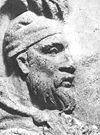- Dacian Fortresses of the Orăștie Mountains
-
Dacian Fortresses of the Orăștie Mountains * UNESCO World Heritage SiteCountry Romania Type Cultural Criteria ii, iii, iv Reference 906 Region ** Europe and North America Inscription history Inscription 1999 (23rd Session) * Name as inscribed on World Heritage List
** Region as classified by UNESCOBuilt in murus dacicus style, the six Dacian Fortresses of the Orăștie Mountains, in Romania, were created in the 1st centuries BC and AD as protection against Roman conquest.[citation needed]
Their extensive and well-preserved remains present a picture of a vigorous and innovative ancient civilization. Today, treasure-hunters sometimes search the area, as Romania lacks legislation in this domain.
The six fortresses - Sarmizegetusa Regia, Costeşti-Cetăţuie, Costeşti-Blidaru, Piatra Roşie, Băniţa and Căpâlna - that formed the defensive system of Decebalus were designated as a UNESCO World Heritage Site in 1999, as well as the settlement and fortifications at Feţele Albe.
Contents
Sarmizegetusa Regia
Main article: Sarmizegetusa RegiaThe town of Sarmizegetusa Regia was the capital and major fortress of the Dacian kingdom, probably built in the mid first century BCE. It consisted of perimeter walls and fortifications, a sacred precinct, and a settlement area primarily for nobles and supporting servants. It was located at the top of a 1200 meter hill with excellent visibility of the surrounding lands. The sacred precinct was on the east side of the town, with a prominent plaza and circular shrines. There were two settlement areas one on the east side and a larger one on the west. In addition to dwellings they included workshops, storage buildings, and agricultural processing areas. Notable for the time is a distribution system for drinking water that used ceramic pipes.[1]
Feţele Albe
Feţele Albe is a Dacian settlement on the southern side of Muncelului Hill, situated north of Sarmizegetusa Regia, separated from it by a sharp declivity. Along with numerous walls and resulting terraces, the site contained a sanctuary with circular stone pillars on the third terrace.[2] The settlement was destroyed during the First Dacian War and rebuilt only to be finally destroyed by fire by Trajan's army during the Second Dacian War in 106 CE.[2][3] The Romans then built a military camp (castrum) on the site.[2]
Piatra Roşie
Piatra Roşie, which means Red Rock, was a Dacian hill fort two days march to the west from Costeşti-Cetăţuie, at Luncani in Boşorod municipality. It was built in two phases. In the first phase a long (102 m) rectangular main citadel was built at the height of land[4] with watch towers on each end and two outlying watch towers. Later the larger area inside the watch towers was enclosed with walls.[5] It appears that the hilltop was flattened in the process in order to produce a usable space.[6]
Gallery
-
Fortress of Blidaru
-
Sanctuaries at Sarmizegetusa Regia
-
Andesite sanctuaries, Sarmizegetusa Regia
-
Solar disc, Sarmizegetusa Regia
-
Murus dacicus, Sarmizegetusa Regia
-
Paved Dacian road, Sarmizegetusa Regia
See also
- Burebista
- List of Dacian towns
- Murus dacicus
- Sarmizegetusa Regia
Notes
- ^ Mallows, Lucy (2008) Transylvania Bradt Travel Guides, Chalfont St. Peter, Bucks, United Kingdom, page 219, ISBN 978-1-84162-230-9
- ^ a b c MacKendrick, Paul Lachlan (1975) The Dacian Stones Speak University of North Carolina Press, Chapel Hill, North Carolina, pages 60–61, ISBN 0-8078-1226-9
- ^ Daicoviciu, Hadrian and Glodariu, Ioan (1969) "Consideratii asupra cronologiei asezarii dacice de la Fetele Albe" Acta Musei Napocensis 6: pp. 465–473, in Romanian
- ^ Aerial photograph shows hill at Luncani. Oltean, Ioana Adina (2007) Dacia: landscape, colonisation and romanisation Psychology Press, London, page 81, ISBN 0-415-41252-8
- ^ MacKendrick, Paul Lachlan (1975) The Dacian Stones Speak University of North Carolina Press, Chapel Hill, North Carolina, pages 58–60, ISBN 0-8078-1226-9
- ^ Oltean, Ioana Adina (2007) Dacia: landscape, colonisation and romanisation Psychology Press, London, page 95, ISBN 0-415-41252-8
References
Further reading
External links
- The Dacians - pictures of the fortresses in the Orastie Mountains
- UNESCO: The Dacian Fortresses of the Orastie Mountains
- Tourist information and maps from the Museum of Dacian and Roman Civilisation
Dacia topics Dacian tribes: Aedi · Albocense · Anartes · Apuli · Artakioi · Biephi · Biessoi · Buri · Carpi · Cauci · Ciaginsi · Clariae · Costoboci · Cotini · Crobidae · Daci · Getae · Moesi · Osi · Peukini · Piephigi · Potulatense · Predasense · Rhadacense · Saldense · Scaugdae · Sense · Suci · Terizi · Teurisci · Trixae · Tyragetae · Troglodytae
Dacian kings: Culture and civilisation: Art, jewellery, treasures, tools (Bracelets) · Clothing · Foreign Relations (Greeks · Celts · Romans · Germanic tribes) · Warfare (Falx · Sica · Thracian warfare)
Sarmizegetusa · Argidava · Buridava · Cumidava · Piroboridava · Sucidava · More towns... · Davae · Dacian Fortresses of the Orăştie Mountains · Murus dacicusWars with the
Roman Empire:Roman Dacia: Dacia Traiana · Moesia · Scythia Minor · Dacia Aureliana · Diocese of Dacia · Dacia Mediterranea · Dacia Ripensis · Trajan (Bridge · Column) · Towns and cities · Castra · Limes (Alutanus · Moesiae · Porolissensis · Sarmatiae · Transalutanus · Trajan's Wall · Brazda lui Novac) · Language (Thraco-Roman · Eastern Romance substratum)Research on Dacia: Books about Dacia · Dacian archaeology · Archaeological sites in Romania · Dacology · Thracology · ProtochronismWikiProject • Commons • Dacian fortresses, settlements, Roman castra, limes from Romania: Google Maps • Google EarthCoordinates: 45°37′23″N 23°18′43″E / 45.62306°N 23.31194°E
Categories:- Articles to be expanded with sources
- World Heritage Sites in Romania
- Dacia
- Dacian towns
- Archaeological sites in Romania
Wikimedia Foundation. 2010.












